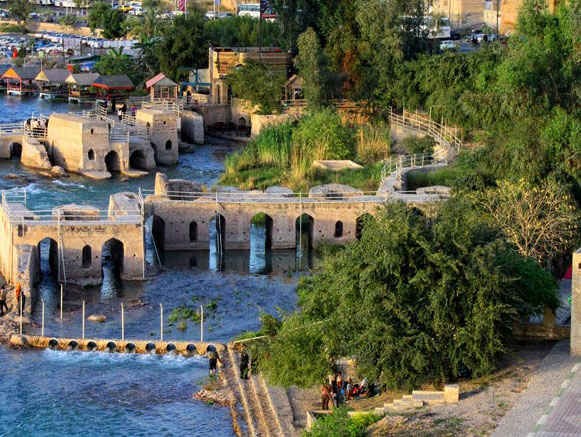Dezful
A city in the Khuzestan province, located in a region whose history dates back to the ancient Iranian civilization. The name Dezful derives from the words Dez (fortress) and Pol (bridge), which combined could mean fortified bridge. The bridge was built during the reign of Shapur I and according to the legends the king exploited the prisoners, in a war against the Romans, to build the bridge. The city has extremely hot and humid summers and mild winters.
Tizno Historic House
It is one of the largest and most beautiful houses in the dock district, which is located on the east side of the district’s main square. The quayside neighborhood is the oldest part of Dezful, named for its proximity to a military castle built to protect the Sassanid Bridge.
Friday Mosque
The second most important historical monument after the Old Bridge of Dezful and, thanks to its architectural features, rooms and stone columns, it is on the list of the first Islamic mosques that were established in the 9th century. The architectural style of the mosque is marked by traces of the Sassanid era, and subsequently the building was inspired by the architectural principles of the early Safavid era.
Yaqub Leys Safari
The Yaqub Leys Safari Mausoleum is located in the village of Shah Abad, 10 kilometers from Dezful. Next to this tomb are the remains of the city of Jondi Shapur.
Yaqub Leys was one of the Iranian kings and the Safari family who ruled in Sistan. Its capital was Zaranj, which is now in Afghanistan. As he was a coppersmith, he became known as “Safar.” Yaqub Leys Safari was the first person to declare Persian as the official language of the country, 200 years after the arrival of Islam in Iran. From then on, no one was allowed to speak in his room in a language other than Persian. He tried to overthrow the Abbasid caliphate and even approached Baghdad, present-day Iraq, which was the capital of the Abbasids at the time. However, he did not survive the colic and died in Jondi Shapur.
Dezful Mills
They are found in the northern part of the Khuzestan region. Dezful’s historic structures and mills include valuable adobe buildings with extraordinary architecture. The historic Dezful mills are an important part of the hydraulic structures of this city that are located in three parts of the Dez River. Dezful’s first water mill was built in Sassanid times and was used even by Qajar and Pahlavi to grind locally grown grain. There are between 5 and 60 mills, some of which are under the old bridge, some are under the new bridge and some are in ‘Ali Kolah’ area. Some of them are destroyed because they are located on the main coastal road. Currently, only 20 mills remain.
Old Dezful Bridge
Being one of the oldest bridges in the world, the bridge was built in Sassanid times. Today this bridge, repaired several times during the Safavid, Qajar and Pahlavi periods, connects the cities of Dezful and Andimeshk. The bridge has four large arches, and between each of them there is a smaller arch. Near the bridge there are the remains of old mills.
Jondi Shapur archaeological site
The ancient city of Jondi Shapur is located 10 km from Dezful, near the village of Shah Abad. Shahpur I was probably in charge of the construction of this city after his victory over the Roman general Valeriano.
Choqa Mish
To the southeast of Dezful, there are clay hills known as Choqa Mish. According to various studies and research, Choqa Mish was the cradle of the pre-invention of calligraphy. The primitive culture of its inhabitants has been verified through their special clay and terracotta modeling method. This culture dates back to about 6000 years before Christ.
Choqa Mish is located in the Susiana plain (present-day Khuzestan province). It is the largest pre-Sassanid settlement in northeast Susiana, and is strategically located between the mouths of the great perennial rivers Dez and Karoon.
Choqa Mish is qualified to demonstrate in one place a number of important developments that took place throughout the Neolithic in Southwest Asia. These theoretical developments include the gradual emergence of central places, increased specialization and improved production of material culture, changes in the subsistence economy, and the emergence of chiefdoms – autonomous political units – and protestate societies.
Among the most notable objects discovered during the excavations are clay balls containing tokens, small spherical balls of clay, pyramids, and other geometric or naturalistic shapes used as accounting devices, number tablets, and stamps.
Among the cylinder seal motifs, unique to this day, are images of the surrender of a fortified city, a victorious ruler on a ship with two prisoners, and a banquet with musicians and a singer. A pair of mythological boats with arches in the shape of human beings drinking from a container with straws is the first appearance of two important motifs in Mesopotamian art, the divine boat of the sun god and banquets.
If you are passionate about mountains, anthropology, historical landscapes and fascinating culture of the Middle East, SITO Travel will help you organize your trip to Iran. Get in touch with us because our experience is born and developed in the field.



Comments